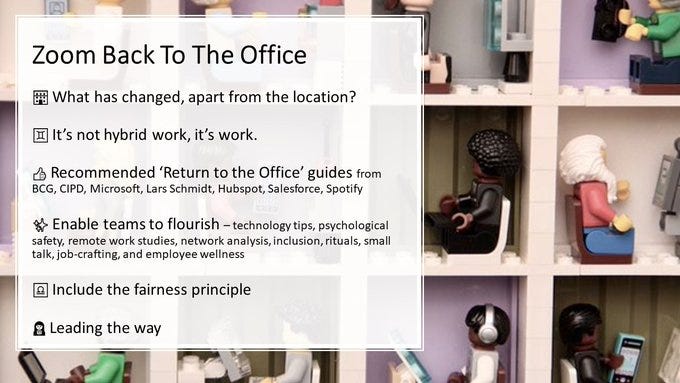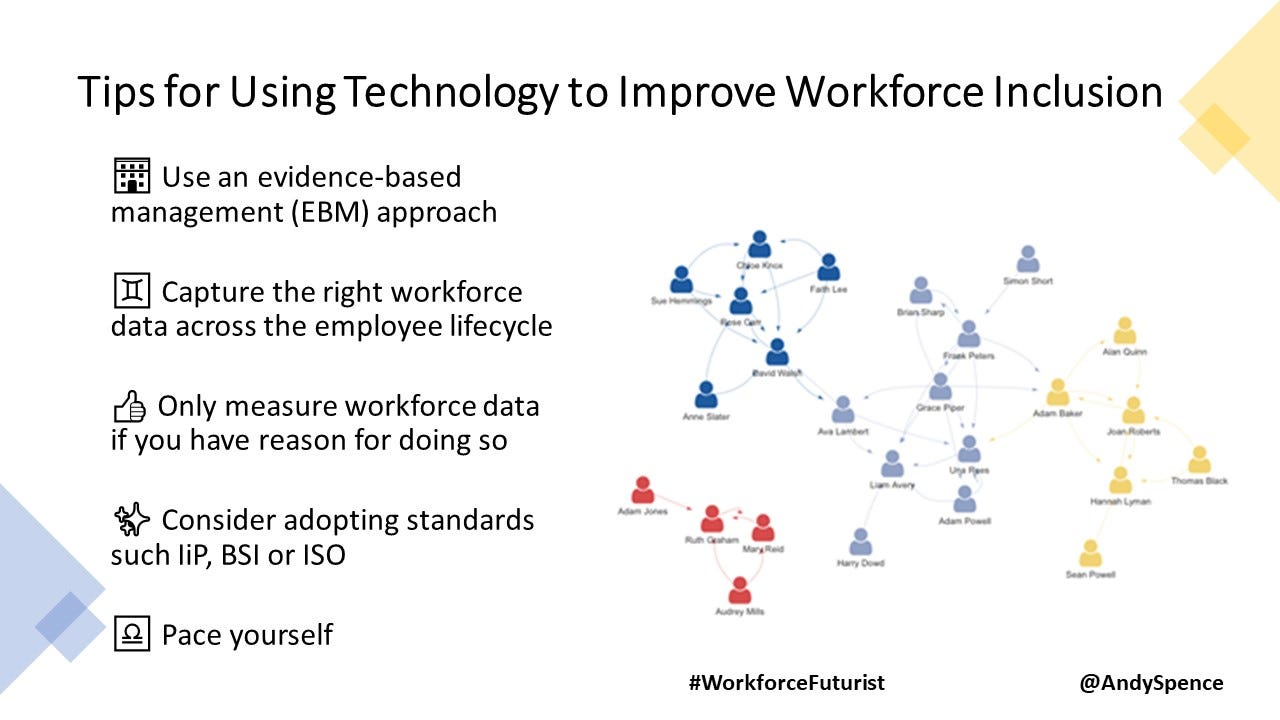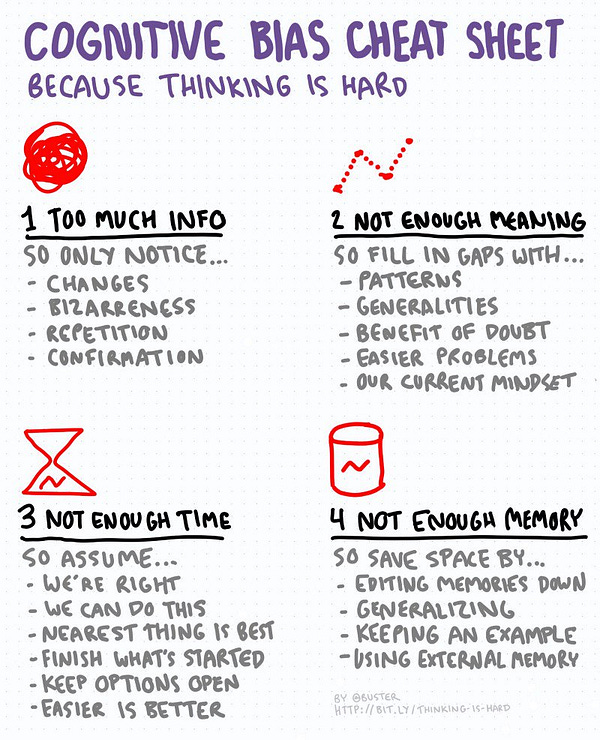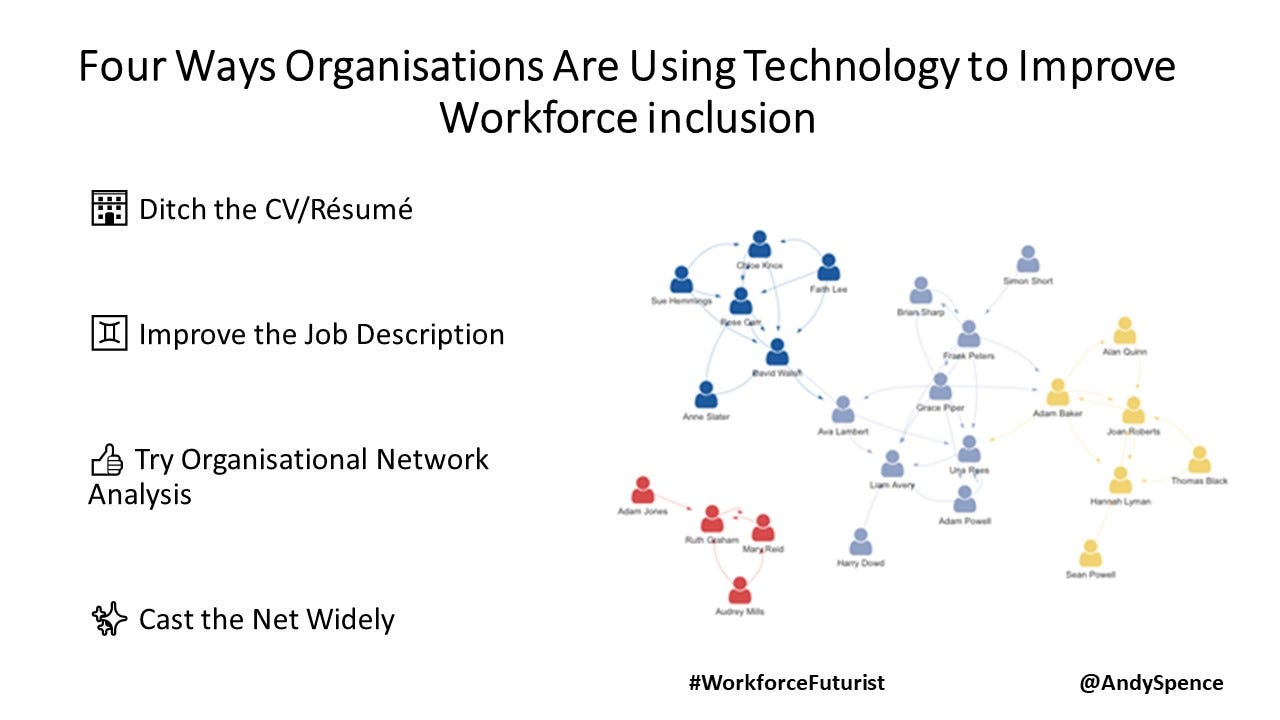How to Improve Workforce Inclusion With Technology
Using an evidence-based approach, with some examples and tips
This is the Workforce Futurist Newsletter about the rapidly changing world of work. Please subscribe if you don’t already for regular posts and longer essays direct to your inbox every week.
In its Gender Gap Report 2018, the World Economic Forum found that 78% of data science and AI professionals globally were male, while 22% were women.
When nearly 80% of those in a team are men, what could go wrong?
I took some photos of several emerging HR Tech vendors using chatbots at a tech conference in Las Vegas and a clear trend emerged.
Jane, Evie, Olivia, Mya, and Ally all appear to be female.
An app is just a tool - algorithms used on data – and it certainly isn’t gendered. Product designers struggle with the challenge that people respond better to an app that has human characteristics.
Let’s flip the AI gender gap problem around.
How can we use AI to hire more women into these teams?
One suggestion is anonymising job descriptions and using tools to make tone and language more inclusive. Tweaking job descriptions will not shift centuries of conditioning, but achieving more balanced and cognitively diverse teams might improve design decisions.
Our experience of the pandemic is influenced by age, health, gender, ethnicity, location, wealth, and occupation. Some occupations have had more exposure to the risk of disease, for example in health care. In certain jobs like dental nurses and midwives, women make up 75% of the roles, with 20% from BAME compared to 11% of the working population.
The Great Return
Organisations with staff working remotely (estimated to be 30-40% of UK workers) are now planning the ‘great return’. There is emerging evidence that the transition back to the office is more likely in male-dominated organisations, and that is less likely to suit women. Every business change impacting the workforce will have a diversity component.
As industries restructure, organisations will need a workforce that is agile enough to respond to changes quickly. A holistic approach is required to ensure that the culture, processes, employee data, workforce technology leadership and practices are aligned.
Good Diversity and Inclusion practices are no different to the steps needed to achieve other business goals. In fact workforce diversity and inclusion is a prerequisite of building successful organisations - see my article on Five Principles for Using Technology to Build Successful Organisations. To change behaviour, organisations need to develop relevant goals and metrics, get buy-in from stakeholders and communicate effectively.
That’s the theory. In practice, many organisations will require a shift in mindset, culture and operational practices. They will also need the right data and technology to make workforce decisions.
Here is a useful guide for leaders planning a return to the office with insights on work design from Microsoft, Spotify and academic researchers.
Tips for Using Technology to Improve Workforce Inclusion
1 - Use an evidence-based management (EBM) process - to identify the root cause of inclusion challenges. Critically assess which practices have a better chance of working in your organisation. Avoid knee-jerk solutions including off-the-shelf training.
Some useful EBM resources:
Center for Evidence-Based Management (CEBMa) - includes lots of useful and free resources on EBM. (I am a professional member)
Science for Work - a useful resource with evidence-reviews on workforce challenges including employee engagement, team work and diversity and inclusion topics.
Diversity Management That Works - An evidence-based view from CIPD (54 page PDF report)
Improving Workplace Culture through Evidence-based Diversity, Equity and Inclusion Practices - led by Stephanie Creary Ph.D, from Wharton School of the University of Pennsylvania (62 page PDF report)
2 - Capture the right workforce data across the employee lifecycle. A CIPD survey with UK employers found 71% of employers report on gender, but just 21% report on BAME diversity. The only legal requirements UK employers have to report on diversity demographics regard gender and, in Northern Ireland, religion. Descriptive workforce measures might include distribution of age, gender, tenure, disability and sexual orientation or gender identity. Other people data includes pay, promotions, employee turnover, and grievance data. Broader demographic categories might include social class. Workers who come from lower social-class origins in the United States are 32% less likely to become managers than those who come from higher social-class origins.
3 - Only measure workforce data if you have a reason for doing so. Understand the nature and extent of organisational challenges, for example, the gender pay gap, inequality in career progression, or barriers to participation in work for those with disabilities or caring responsibilities.
4 - Root out Bias in your existing management and HR processes by conducting a review and making high impact changes. Humans are susceptible to many different types of bias from affinity bias (we feel as though we have a natural connection with people who are similar to us) to confirmation bias (we look to confirm our own opinions and pre-existing ideas about a particular group of people) and these apply to HR processes.
5 - Consider adopting standards such as the BSI and ISO HR management suite and Investors in People (IiP) to provide principled based frameworks and guidelines and to ensure people polices and working practices are bias free.
6 - Pace yourself - longer-term changes to working practices and infrastructure take time. Prioritise ruthlessly with high-impact, lower effort changes.
If you know anyone in your network who might enjoy this article then please share👇
Four Ways Organisations Are Using Technology to Improve Workforce Inclusion
Ditch the CV/Résumé
Applied have a tool that gets rid of CVs, and tests for skills and work samples upfront. This is because the more we know about a candidate, the more grounds for bias we have, so anonymous applications are used. An industrial manufacturer used people analytics to look at the talent acquisition process and uncovered that as women moved through the hiring process, more were dropped during the interview stage. The company took strategic, programmatic action to reduce unconscious bias and increased the success rate of women and minorities entering and advancing through the hiring process.
Improve the Job Description
JDs are often subject to plenty of ‘cutting and pasting’. Textio has been used to statistically analyse response patterns to different words, including in the job description. With gender responses, the phrase, “Work hard play hard” or “Coding Ninja” attracted more men to adverts, and words such as “adaptable and creative” attracted more women.
Make sure you have the capability to measure workforce sentiment, and managers are empowered to not only listen but to act to make improvements.
Try Organisational Network Analysis
Look at actual socialising behaviour to see if different groups behave in different ways. ONA has proved to be effective in diversity and inclusion initiatives monitoring collaboration patterns by gender, age and ethnicity. This can highlight potential conflict areas where intervention might be needed. For example, a software firm found that there were gender differences in promotion to manager, even though the graduate intake was balanced. By looking at socialising behaviour they were able to make interventions such as mentoring to reduce gender differences.
Cast the Net Widely
For business changes, including new products and services, ask the people who are closest to the customer – your employees. Ensure that the demographics of responses reflect your customer base.
PwC has an inclusion goal to apply the same level of attention to the disadvantages of social class that it was already applying to those of gender, ethnicity, and race. The company has a goal to help 25,000 young people develop workplace skills through programmes with schools and colleges across the UK, with a particular focus on social mobility coldspot areas.
The Upshot on Using Technology in Workforce Inclusion
To improve inclusion in the workforce, the solution is not to focus on a particular demographic, run D&I as yet another HR silo, or launch a round of unconscious bias training. The longer-term solution for HR is to generally improve workforce analytics, culture, processes and leadership to ensure that the organisation has the capability to make necessary changes. This involves listening to all workers, to hear what they are saying and to act in a meaningful way.
Technology is not the whole answer but can help to improve workforce inclusion, fairness and productivity if implemented sensibly using evidence-based practice.
Andrew Spence is an independent workforce strategist and writes the Workforce Futurist Newsletter.
Thanks to Alex Evans.
This article was originally published in TALiNT International May/Jun 2021








